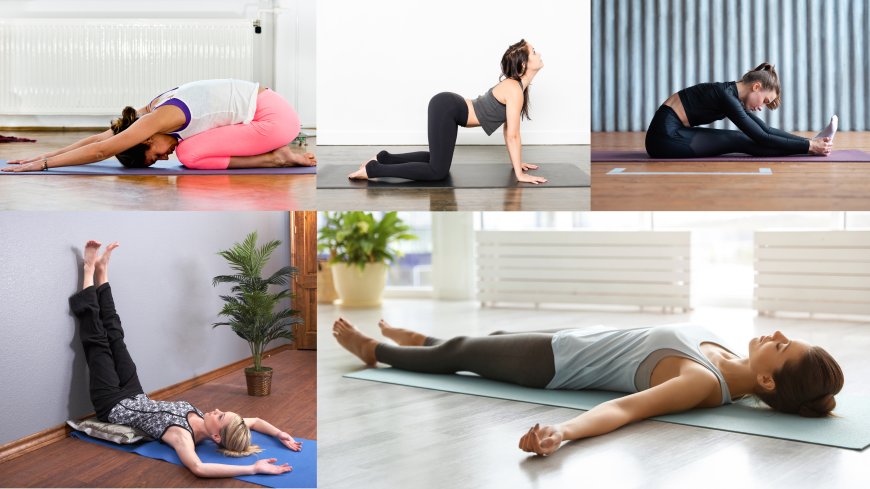Yoga for Stress Relief: Best Poses & Breathing Techniques
Discover how yoga relieves stress, promotes relaxation, and improves mental clarity. Learn the best poses and breathing techniques for a calmer mind & body.

In today's fast-paced world, stress is an unavoidable part of life. Whether it stems from work, personal responsibilities, or external pressures, stress can significantly impact both our mental and physical well-being. While there are many ways to manage stress, yoga has proven to be one of the most effective methods. Through mindful movement, deep breathing, and relaxation techniques, yoga helps calm the nervous system, reduce anxiety, and improve mental clarity. In this article, we'll explore how yoga relieves stress and highlight some of the best poses to incorporate into your practice.
How Yoga Helps Relieve Stress
Yoga is more than just physical exercise; it is a holistic practice that integrates movement, breath control, and mindfulness. When practiced regularly, yoga activates the parasympathetic nervous system—the body’s relaxation response—helping to lower cortisol levels, reduce heart rate, and calm the mind. The following key elements of yoga contribute to stress relief:
-
Breath Awareness: Deep, controlled breathing promotes relaxation and oxygenates the brain, reducing feelings of anxiety.
-
Mindful Movement: Flowing through poses with intention helps to release tension in the body and bring focus to the present moment.
-
Meditation and Mindfulness: Yoga encourages self-awareness and a mindful approach to thoughts and emotions, reducing stress and increasing resilience.
-
Physical Relaxation: Certain poses help stretch tight muscles, relieve physical tension, and promote overall relaxation.
Best Yoga Poses for Stress Relief
Here are some of the best yoga poses to calm your mind and ease tension in the body.
1. Child’s Pose (Balasana)
This gentle resting pose helps stretch the lower back, hips, and thighs while calming the nervous system and promoting relaxation.
How to do it:
-
Start on your hands and knees.
-
Sit your hips back toward your heels, extending your arms forward.
-
Lower your forehead to the mat and relax your shoulders.
-
Hold for several breaths, allowing your body to release tension.
2. Cat-Cow Pose (Marjaryasana-Bitilasana)
This dynamic movement between two poses helps release tension in the spine, neck, and shoulders while synchronizing breath and movement.
How to do it:
-
Begin in a tabletop position with your hands and knees on the mat.
-
Inhale as you arch your back, lifting your head and tailbone (Cow Pose).
-
Exhale as you round your spine, tucking your chin toward your chest (Cat Pose).
-
Repeat for several rounds, focusing on your breath.
3. Seated Forward Fold (Paschimottanasana)
This stretch releases tension in the back, hamstrings, and shoulders while calming the mind.
How to do it:
-
Sit on the floor with your legs extended straight.
-
Inhale to lengthen your spine.
-
Exhale and fold forward, reaching for your feet or shins.
-
Hold for several breaths, keeping your back relaxed.
4. Legs Up the Wall (Viparita Karani)
This restorative pose enhances circulation, relieves lower back tension, and promotes relaxation.
How to do it:
-
Sit close to a wall and lie on your back.
-
Swing your legs up the wall, keeping your feet flexed.
-
Allow your arms to rest at your sides, palms facing up.
-
Breathe deeply and hold for several minutes.
5. Savasana (Corpse Pose)
Savasana is the ultimate relaxation pose that helps integrate the benefits of your yoga practice.
How to do it:
-
Lie on your back with your arms and legs relaxed.
-
Close your eyes and focus on deep, slow breaths.
-
Let go of all tension and remain in this pose for at least five minutes.
Breathing Techniques to Enhance Relaxation
Incorporating breathwork into your yoga practice enhances its stress-relieving benefits. Here are two effective techniques:
1. Deep Breathing (Diaphragmatic Breathing)
This technique promotes full oxygen exchange, reducing stress and promoting relaxation.
How to do it:
-
Sit or lie comfortably.
-
Inhale deeply through your nose, allowing your belly to expand.
-
Exhale slowly through your mouth.
-
Repeat for several breaths.
2. Alternate Nostril Breathing (Nadi Shodhana)
This practice balances the nervous system and calms the mind.
How to do it:
-
Sit comfortably and use your thumb to close one nostril.
-
Inhale through the open nostril.
-
Close the opposite nostril and exhale through the other side.
-
Repeat for several rounds.
Tips for Practicing Yoga for Stress Relief
To maximize the stress-relieving benefits of yoga, keep these tips in mind:
-
Practice Regularly: Consistency is key. Aim for at least a few minutes of yoga each day.
-
Focus on Your Breath: Always sync your breath with movement to stay present and mindful.
-
Be Gentle with Yourself: Avoid pushing too hard; listen to your body and move at your own pace.
-
Create a Peaceful Environment: Practice in a quiet, comfortable space with soft lighting and calming music.
-
Use Props if Needed: Blocks, straps, or cushions can enhance comfort and support.
Conclusion
Yoga is a powerful tool for managing stress and promoting relaxation. By incorporating mindful movement, breathwork, and restorative poses into your routine, you can effectively reduce tension and cultivate inner peace. Whether you're a beginner or an experienced yogi, these stress-relieving techniques can help you navigate life's challenges with greater ease. Start small, stay consistent, and enjoy the calming benefits of yoga—one breath at a time.
What's Your Reaction?
 Like
0
Like
0
 Dislike
0
Dislike
0
 Love
0
Love
0
 Funny
0
Funny
0
 Angry
0
Angry
0
 Sad
0
Sad
0
 Wow
0
Wow
0























